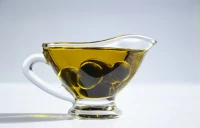Olive oil is simply the juice extracted from fresh olives—no chemicals, heat, or further processing.
To qualify as extra-virgin, the highest grade, the oil has to pass lab analysis and sensory tests set by the Madrid-based International Olive Council.
But there’s ample room for deception along the production chain, as olive oil extracted in one country is often shipped to another, usually Italy, and then blended with olive oils from yet other places before being bottled and shipped off again.
Fake EVOO, in the worst-case (and illegal) scenario, is diluted with a cheap soybean or seed oil or mixed with lower-grade olive oil that’s been chemically refined.
Or, as is most common according to Olmsted, it’s mixed with olive oil that’s been sitting around since the previous year’s harvest or longer. This is legal, but by the time that bottle reaches the store, it’s subpar, diminished of its wonderful health benefits, and wouldn’t pass the IOC’s muster.




